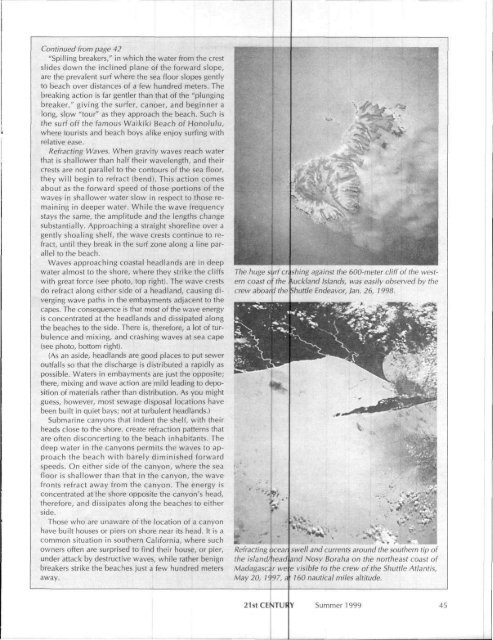Back to the Moon with Nuclear Rockets
Back to the Moon with Nuclear Rockets
Back to the Moon with Nuclear Rockets
- No tags were found...
Create successful ePaper yourself
Turn your PDF publications into a flip-book with our unique Google optimized e-Paper software.
Continued from page 42"Spilling breakers," in which <strong>the</strong> water from <strong>the</strong> crestslides down <strong>the</strong> inclined plane of <strong>the</strong> forward slope,are <strong>the</strong> prevalent surf where <strong>the</strong> sea floor slopes gently<strong>to</strong> beach over distances of a few hundred meters. Thebreaking action is far gentler than that of <strong>the</strong> "plungingbreaker," giving <strong>the</strong> surfer, canoer, and beginner along, slow "<strong>to</strong>ur" as <strong>the</strong>y approadh <strong>the</strong> beach. Such is<strong>the</strong> surf off <strong>the</strong> famous Waikiki Beach of Honolulu,where <strong>to</strong>urists and beach boys alike enjoy surfing <strong>with</strong>relative ease.Refracting Waves. When gravity waves reach waterthat is shallower than half <strong>the</strong>ir wavelength, and <strong>the</strong>ircrests are not parallel <strong>to</strong> <strong>the</strong> con<strong>to</strong>urs of <strong>the</strong> sea floor,<strong>the</strong>y will begin <strong>to</strong> refract (bend). This action comesabout as <strong>the</strong> forward speed of those portions of <strong>the</strong>waves in shallower water slow in respect <strong>to</strong> those remainingin deeper water. Whilel<strong>the</strong> wave frequencystays <strong>the</strong> same, <strong>the</strong> amplitude and <strong>the</strong> lengths changesubstantially. Approaching a straight shoreline over agently shoaling shelf, <strong>the</strong> wave crests continue <strong>to</strong> refract,until <strong>the</strong>y break in <strong>the</strong> surf zone along a line parallel<strong>to</strong> <strong>the</strong> beach.Waves approaching coastal headlands are in deepwater almost <strong>to</strong> <strong>the</strong> shore, where <strong>the</strong>y strike <strong>the</strong> cliffs<strong>with</strong> great force (see pho<strong>to</strong>, <strong>to</strong>p right). The wave crestsdo refract along ei<strong>the</strong>r side of a Headland, causing divergingwave paths in <strong>the</strong> embayments adjacent <strong>to</strong> <strong>the</strong>capes. The consequence is that most of <strong>the</strong> wave energyis concentrated at <strong>the</strong> headlands and dissipated along<strong>the</strong> beaches <strong>to</strong> <strong>the</strong> side. There is, <strong>the</strong>refore, a lot of turbulenceand mixing, and crashing waves at sea cape(see pho<strong>to</strong>, bot<strong>to</strong>m right).(As an aside, headlands are good places <strong>to</strong> put seweroutfalls so that <strong>the</strong> discharge is distributed a rapidly aspossible. Waters in embayments are just <strong>the</strong> opposite;<strong>the</strong>re, mixing and wave action are mild leading <strong>to</strong> depositionof materials ra<strong>the</strong>r than distribution. As you mightguess, however, most sewage disposal locations havebeen built in quiet bays; not at turbulent headlands.)Submarine canyons that indent <strong>the</strong> shelf, <strong>with</strong> <strong>the</strong>irheads close <strong>to</strong> <strong>the</strong> shore, create refraction patterns thatare often disconcerting <strong>to</strong> <strong>the</strong> beach inhabitants. Thedeep water in <strong>the</strong> canyons permits <strong>the</strong> waves <strong>to</strong> approach<strong>the</strong> beach <strong>with</strong> barely diminished forwardspeeds. On ei<strong>the</strong>r side of <strong>the</strong> canyon, where <strong>the</strong> seafloor is shallower than that in <strong>the</strong> canyon, <strong>the</strong> wavefronts refract away from <strong>the</strong> canyon. The energy isconcentrated at <strong>the</strong> shore opposite <strong>the</strong> canyon's head,<strong>the</strong>refore, and dissipates along <strong>the</strong> beaches <strong>to</strong> ei<strong>the</strong>rside.Those who are unaware of <strong>the</strong> location of a canyonhave built houses or piers on shore near its head. It is acommon situation in sou<strong>the</strong>rn California, where suchowners often are surprised <strong>to</strong> find <strong>the</strong>ir house, or pier,under attack by destructive waves, while ra<strong>the</strong>r benignbreakers strike <strong>the</strong> beaches just a few hundred metersaway.The huge surf cr< shing against <strong>the</strong> 600-meter cliff of <strong>the</strong> westerncoast of <strong>the</strong>, \uckland Islands, was easily observed by <strong>the</strong>crew aboard <strong>the</strong> Shuttle Endeavor, Jan. 26, 1998.Refracting ocear swell and currents around <strong>the</strong> sou<strong>the</strong>rn tip of<strong>the</strong> island/head and Nosy Boraha on <strong>the</strong> nor<strong>the</strong>ast coast ofMadagascar we e visible <strong>to</strong> <strong>the</strong> crew of <strong>the</strong> Shuttle Atlantis,May 20, 1997, a 1 160 nautical miles altitude.21stCENTUFY Summer 1999 45
















